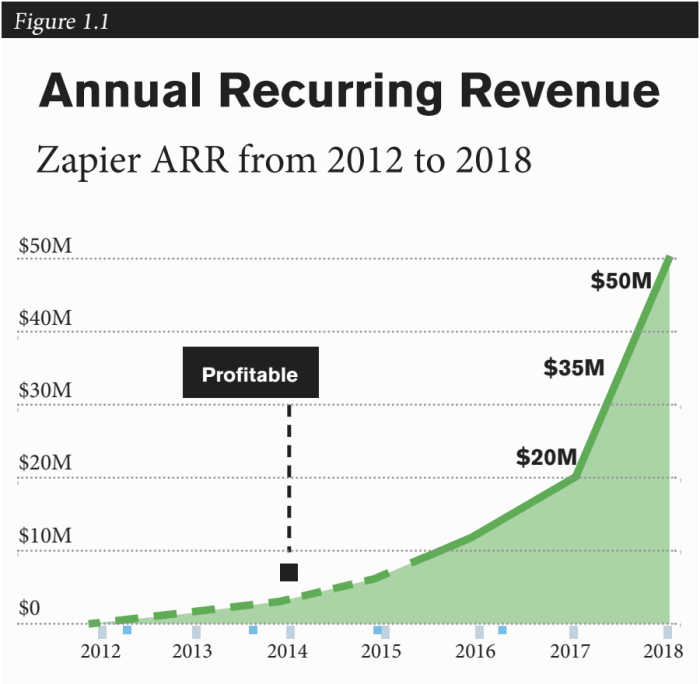Growth planning for any business is unique, fluid, and challenging. Today, business growth strategies need to be agile and set in editable docs, not stone.
This article will break down different types of growth strategies, and explore some of the best business growth plans we’ve seen so far. We’ll also share some insights into creating a growth plan that helps your business go from underdog to top dog—no puppies being harmed en route.
What is a growth strategy?
A business growth strategy is a collection of tactics designed to help your business increase its market share.
It can be a short or long-term plan, focusing on key areas your business needs to work on for sustainable growth.
The best growth strategy facilitates competitors, resources, industry, value proposition, revenue opportunities, product, lead generation, and copious amounts of data.
What types of growth strategies are there?
There are five types of growth strategies any business can explore, this will largely depend on your business goals and growth mission. The main five growth strategies are:
Market penetration
Product development
Market development
Diversification strategies
Acquisition strategies
Let’s dive into these in some more detail.
1. Market Penetration Strategy
This one is in the hands of your marketing team. Market penetration growth strategy takes the product you already have, alongside the market you’re already in. If you're still not clear about your product-market fit, work on that first to ensure you're developing the right product for the right market.
The market can refer to a geographical market, an age group, or a gender—however, you choose to segment your audience.
Your marketing team then needs to dive deeper into that market by ramping up growth marketing strategies, expanding and exploring new marketing avenues, updating existing campaigns, or snagging customers from competitors with convenient pricing and shinier USPs.
2. Product Development Strategy
You’ve guessed it—this falls into the hands of your product team. Product development growth strategy includes developing a new product or feature for your current user base.
This product-led growth should help your business continue striving towards its larger mission and vision. We’re not reinventing the wheel with this strategy; we’re enhancing the wheel with excellent onboarding, customer feedback, and streamlined processes.
3. Market Development Strategy
With a little research, this marketing growth strategy can take a business far. It’s a prime strategy for SMBs and requires you to pull data from your audience insights.
Perhaps you can identify a trend in sales to a percentage of people that you didn’t expect to be interested in your product upon launch.
A market development growth strategy identifies pockets of new people interested in your product and adapts your marketing and sales strategy to sell to those people.
Also referred to as market expansion, with some smart heads, this growth strategy can do wonders for your business in its early growth years.
4. Diversification Strategy
This is a growth marketing strategy that is mostly considered when a business has already established itself as an industry leader and is ready to take on more. It involves many departments from your business to be done successfully and is certainly not for the pups among us.
A diversification growth strategy is a plan that means businesses will enter new markets with a new product. This comes hand in hand with a ton of audience and product research. It will require rapid prototyping, agile marketing, and smart selling.
5. Acquisition Strategy
Up until now, we’ve discussed internal growth strategies to help your business shine. However, a major external growth strategy is acquisition. An acquisition growth strategy is not just a strategy to wipe out the competition.
An acquisition strategy has many contributing factors and can help your business penetrate new markets or dive deeper into your current one. For example, Microsoft acquired Github so they could strengthen developer relationships, and Adobe acquired Marketo so that they could “widen their customer experience across B2C and B2B and put Adobe Experience Cloud at the heart of all marketing”.
An acquisition can help your brand own a new product or a feature that’s already in line with what your customers want and need.

Free in-product marketing mini-course
Learn feature launches, upsells, and onboarding from products like Stripe and Dropbox. Get lesson #1 now 👇
5 growth strategy examples you can learn from
It’s all well and good to understand different growth strategies, but bringing them to life is something best led by example. Let's dive into four successful companies that crushed their growth strategy goals. We'll take a look at how they planned for current and future challenges, drew new customers, and managed to increase revenue.
Dropbox: Referral-based growth
The cloud-based file storage platform reported total revenue of $591 million in Q3 2022, experiencing a growth of 9.7% year over year despite the headwinds of recession threats. Dropbox now boasts 17.55 million paying users, as compared to 16.49 million for the same period in 2021. How did the storage giant get to a position where they've continued to experience business expansion even during difficult times?
One word: referrals.
Back in September 2008, Dropbox had 100k registered users; the following year, that jumped to a whopping 4M registered users. They achieved an astonishingly rapid growth of 3900% growth in 15 months with a succinct growth plan.
The business model operates on a freemium service and gives users 500MB of storage—up to 16GB of storage, for every friend someone signs up.
The Dropbox growth strategy example is potentially one of the first cases of data being the new currency among referral programs. Typically, companies would pay for a referral, but Dropbox grew with a “cash is king” mentality and exchanged storage instead.

(Source)
The Dropbox referral program threaded into user onboarding laid out clear reward goals and maintained a link-building and referral mechanism with fantastic UX.
Zapier: Targeted Content Marketing
In 18 months, Zapier doubled customer lifetime value, managing to 4x its revenue to $50 million. The company's success lies in content.
The SaaS integration platform always focused on its users and where they are. The content team built search authority via every new integration birthed—now sitting at 2,000+ integrations.

(Source)
Zapier is focused heavily on co-content marketing strategies, partnering with some power-houses like Airtable, Discord, and Squarespace.
“As new apps launch, and as new products from existing companies launch, we focus on just trying to have ubiquity because when we support the things that people use, then Zapier becomes useful for them,” says Zapier CEO, Wade Foster.

Terminus: Creating its own category
What do you do when the existing market is already flooded with competitors? You can try to push through the high customer acquisition cost and brute force your way in by lowering prices.
Or, you can carve your own path in that sector and create a new market, like what Terminus did. Don't forget to bring others along for the ride.
Over to Dan Sanchez, Co-host of the B2B Growth podcast and Director of Audience Growth at Sweet Fish Media to explain further.
Postmates: Agile Product Building
The food-delivery service, reaching 3,500 cities across the US and 70% of the country’s households, kicked up enough business growth to be acquired by Uber with a $2.65 billion, all-stock deal in July 2020.
The company was led by a product growth-focused mission that set out to: “enable anyone to have anything delivered to them, on-demand", according to co-founder and CEO Bastian Lehmann.
How did they answer their mission? Product innovation.
Currently making 5 million deliveries a month, Postmates introduced an app for Shopify merchants to enable a 2-hour delivery window, a free group delivery option to save some cash: Postmates party, and most recently Curbside Pickup to responsibly accelerate small businesses returning to a new normal, post-crisis.
A pro tip: if you're building your own Shopify store, go through the Shopify SEO checklist first, to ensure greater visibility and higher reach to your customers.
What you can learn from this growth strategy example? Use your own product to drive growth in your business and create growth opportunities and loops that do the hard work for you.

(Source)
Buzzfeed: Creating for shareability
The content wizards at BuzzFeed were creating, arguably, one of the most shareable business models the internet had ever seen. Today, Buzzfeed has a global audience of over 520+ million, and over 3+ billion content views per month.
Despite its questionable profitability in recent years—currently scraping a 7% growth rate from 2018—there’s no doubting the business’s viral growth.
How did they do it?
Instead of following the organic growth strategy of writing for Google search, Buzzfeed focused on writing for humans. They were no longer writing for bots with strategically placed keywords. Instead, they were writing for shares. Launching during social media's earliest years, social entries to the site accounted for over 50% of Buzzfeed’s web traffic back in 2011.
Today the company is shifting its business growth strategy to match the times. At the beginning of 2020, BuzzFeed Founder & CEO Jonah Peretti announced new businesses that generate over $200 million in revenue and are growing at 40% year-on-year. In Q2 2021, BuzzFeed revenues grew 51% over the corresponding period last year, while content revenue increased 5% to $24.2 million, reflecting the recovery from the impact of COVID-19. As of 2022, BuzzFeed has still achieved growth despite the economic uncertainties. Its Q3 2022 revenue was $103.7 million, growing 15% compared to Q3 2021.

(Source)
Some of Buzzfeed's viral business growth strategies include a Media Network, TV content, and a focus on building global communities. These strategies will give Buzzfeed more control over its content, distribution, and algorithms to bring people more of what they love—giving a more personalized content experience.
Buzzfeed tactics for SaaS companies
We all want our content to be shared on social media platforms, but most of us don't have the reach and following that Buzzfeed does.
Start small and build it up. One piece of content can be shared in multiple ways, as Dan explains.
Top tips for creating an effective growth strategy
A powerful growth strategy is never the same as another. It’s also never a rinse-and-repeat process for big or small businesses. Growth strategies work, but they need to be tailored to business needs, the niche, and technology, as well as to the product adaption curve stage.
However, there are some tips for creating your own growth strategy that should come into play no matter your business model, or the growth trajectory you’re shooting for. Thread these tips into your product launch roadmap or new business plan.
1. Learn from your competition
Your competition is called competition for a reason, they’re doing something right. Identify what their special sauce is—then recreate it with better, organic ingredients.
2. Identify revenue opportunities
Growth is great, but business growth needs to be revenue-centered. If you’re not growing financially, then your business model is not sustainable. Lockdown where you can generate revenue and target your growth in that direction.
3. Stay true to your mission
It can be easy for businesses to chase goals and metrics and lose sight of why they started in the first place. Any growth strategy should encompass your larger mission and vision. For this purpose, you can use an executive summary template to create your business plan summary and ensure that you're heading in the right direction.
4. Invest in smart minds
Invest time and financial resources in finding smart minds that are right for your business and growth goals. Look for people who have worked in cross-functional teams before who can drive forward your growth strategies.
5. Lead with ideas first
Don’t be limited by your resources or financial position. Great ideas start on paper, engineering how they come to life is the second step. Test ideas in-product with Microsurveys so you can get an on-the-pulse feeling about what users want, or use a fake door test to gauge how people would react to new features.
Start with zero limitations and get scrappy with how you make an idea breathe, perhaps they don’t need as much financial support as you originally thought.
6. Identify your ideal customer
Your ideal customer is not an ethnicity, gender, or sitting in one geographical location. Identify your ideal customer through their problem and the solution they’re looking for—this will better help you identify the market growth and penetration strategies.
7. Use the data you have
Data is such an important currency. Use the data you have to help make smart decisions. Never underestimate a data bank going on its size—no matter how big or small your audience is, any insight is better than none.
Final wrap up
Growth planning for any business needs to be structured, goal-orientated, and mission-driven. Some of the leading examples in business growth have been successful because they’ve stayed on track, and have adapted—when necessary—with the same end goal in mind.
When you’re creating a growth strategy for your business, let those top performers that came before you be a benchmark for internal KPIs.
Don't shy away from new technology or talent to help you get from point A to B as efficiently as possible. Use your growth process as a chance to cherish and champion every opportunity or challenge that comes along the way. Conduct market research and execute growth experiments where opportunities show themselves. A successful business growth plan is about having the courage to continuously innovate and explore.
And lastly, always put your product at the heart of it all. At the end of the day, the strength of your product is what's going to convince people and make them stay.

On-Demand Webinar: Product-Led Growth 101 🚀
How can you use PLG to drive acquisition on autopilot? Become an expert in this 60-minute webinar.





